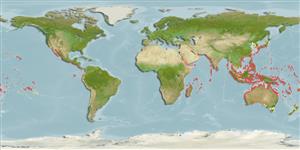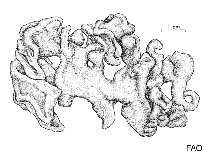Codium arabicum Kützing
Green sea cushion| Native range | All suitable habitat | Point map | Year 2050 |

|
| This map was computer-generated and has not yet been reviewed. |
| Codium arabicum AquaMaps Data sources: GBIF OBIS |
Google image | No image available for this species;
drawing shows typical species in Codiaceae.
Classification / Names Populärnamn | synonymer | CoL | ITIS | WoRMS
Bryopsidophyceae | Bryopsidales | Codiaceae
Environment: milieu / climate zone / djupintervall / distribution range Ekologi
. Tropical
Distribution Länder | FAO områden | Ekosystem | Förekomster | Utplanteringar
Indian Ocean: from Egypt to Mozambique, including the Red Sea, Seychelles, Madagascar, Mauritius, Réunion, Rodrigues and Mascarene Islands, east to India and south to Dampier, Western Australia, including Andaman Sea, Laccadive Islands, Maldives, Sri Lanka and Nicobar Islands; Pacific Ocean: from China to the south China Sea, south to New Zealand, including Federated States of Micronesia, Fiji, Norfolk Islands, the Great Barrier Reef, Lord Howe Island, Tasmania and French Polynesia, east to Chile, including Samoan Archipelago and Hawaiian Islands.
Length at first maturity / Size / Weight / Age
Könsmognad: Lm ? range ? - ? cm
Short description Morfologi
Life cycle and mating behavior Könsmognad | Reproduktion | Lek | Eggs | Fecundity | Larvae
Main reference
referenser | Koordinator | Medarbetare
Guiry, M.D. and G.M. Guiry 2009 AlgaeBase. World-wide electronic publication, National University of Ireland, Galway. http://www.algaebase.org; searched on 14 April 2009. (Ref. 80701)
IUCN Red List Status
(Ref. 130435: Version 2025-1)
CITES status (Ref. 108899)
CMS (Ref. 116361)
Threat to humans
Human uses
Fiskeri: kommersiell
| FishSource |
Verktyg
Ytterligare information
Födosammansättning
Födointag
Predatorer
Max. ages / sizes
Length-weight rel.
Length-length rel.
Length-frequencies
Mass conversion
Abundans
Könsmognad
Fecundity
Lek
Eggs
Egg development
Larvae
Internet-källor
BHL | BOLD Systems | CISTI | DiscoverLife | FAO(Publication : search) | Fishipedia | GenBank (genome, nucleotide) | GloBI | Gomexsi | Google Books | Google Scholar | Google | PubMed | AlgaeBase | Tree of Life | Wikipedia (Go, sök) | Zoological Record



